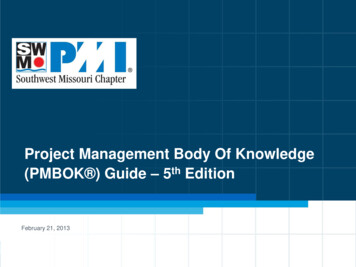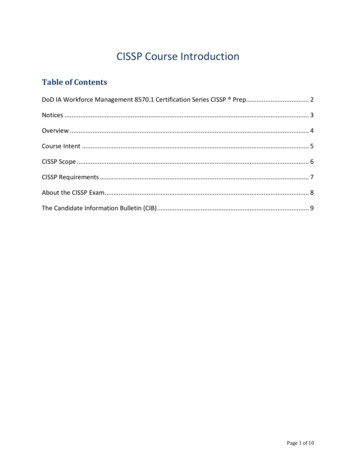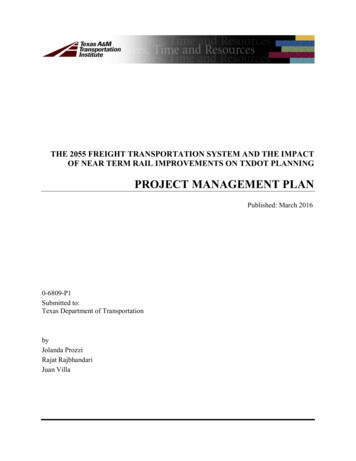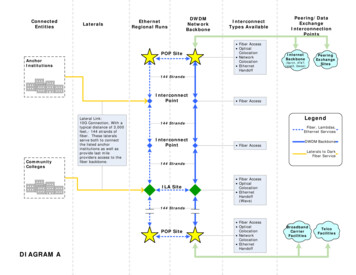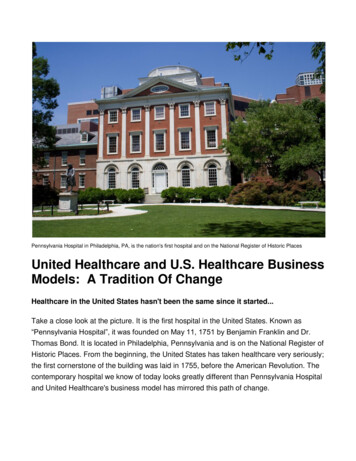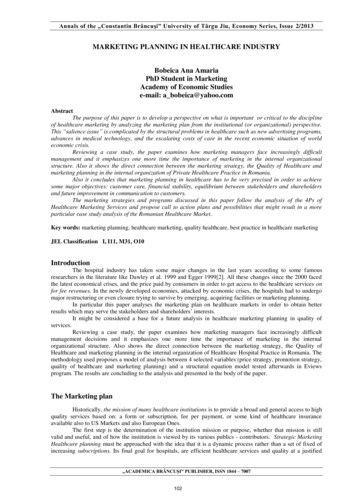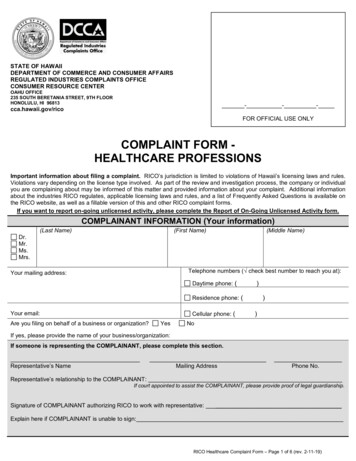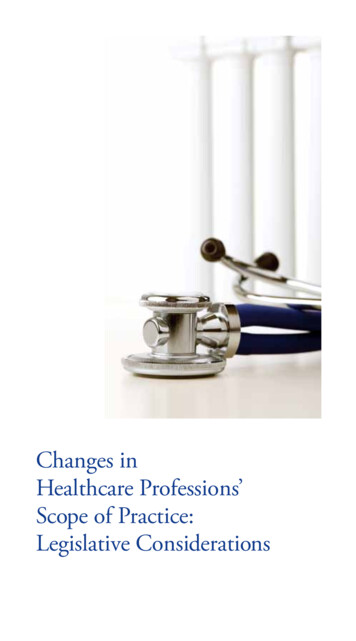
Transcription
Changes inHealthcare Professions’Scope of Practice:Legislative Considerations
This document is the result of collaboration between thefollowing organizations:Association of Social Work Boards (ASWB)Federation of State Boards of Physical Therapy (FSBPT)Federation of State Medical Boards of the United States, Inc. (FSMB)National Association of Boards of Pharmacy (NABP )National Board for Certification in Occupational Therapy, Inc. (NBCOT )National Council of State Boards of Nursing, Inc. (NCSBN )Table of ContentsExecutive Summary . . . . . . . . . . . . . . . . . . . . . . . . . . . . .3Changes in Healthcare Professions’ Scope of Practice:Legislative Considerations . . . . . . . . . . . . . . . . . . . . . . . . . .5PurposeBackgroundHistorical ContextIntroductionThe Purpose of Regulation . . . . . . . . . . . . . . . . . . . . . . . . .7Defining Scope of PracticeAssumptions Related to Scope of PracticeThe Basis for Decisions Related to Changes inScope of Practice . . . . . . . . . . . . . . . . . . . . . . . . . . . . . . 9Historical BasisEducation and TrainingEvidenceRegulatory EnvironmentThe Basis for Legislative Decision Making . . . . . . . . . . . . . . . . 12Conclusion . . . . . . . . . . . . . . . . . . . . . . . . . . . . . . . . . 13Appendix . . . . . . . . . . . . . . . . . . . . . . . . . . . . . . . . . . 14
Anew era of healthcare reformis sweeping state and federalgovernment in the U.S. During thesedifficult economic times policymakersare faced with many challenges, notthe least of which are legislativeand regulatory debates on how to maximize the use of allhealthcare practitioners and the debate among healthcarepractitioners regarding the continuous evolution of scopesof practice. Law and rule makers charged with consumerprotection will find this document helpful in guidingdiscussions on how the most effective and efficient carecan be delivered to the American public in an era ofcontinuous changes in healthcare.
Executive SummaryThis document is a result of a collaborativeeffort in 2006 by representatives from sixhealthcare regulatory organizations. It hasbeen developed to assist legislators andregulatory bodies with making decisionsabout changes to healthcare professions’scopes of practice.Proposed changes to a healthcare professions’scope of practice often elicit strongly wordedcomments from several professional interestgroups. Typically, these debates are perceived as turf battles betweentwo or more professions, with the common refrain of “this is part of mypractice so it can’t be part of yours.” Often lost among the competingarguments and assertions are the most important issues of whether thisproposed change will better protect the public and enhance consumers’access to competent healthcare services.Healthcare education and practice have developed in such a way thatmost professions today share some skills or procedures with otherprofessions. It is no longer reasonable to expect each profession tohave a completely unique scope of practice, exclusive of all others. Webelieve that scope of practice changes should reflect the evolution ofabilities of each healthcare discipline, and we have therefore attemptedto develop a rational and useful way to make decisions when consideringpractice act changes.Based on reports from the Institute of Medicine1 and the PewHealthcare Commission2 we propose a process for addressing scopeof practice, which is focused on patient safety. The question thathealthcare professionals must answer today is whether their professioncan provide this proposed service in a safe and effective manner. Ifan issue does not address this question, it has no relevance to thediscussion.1Crossing the Quality Chasm: A New Health System for the 21st Century, The Institute ofMedicine, National Academy Press, 2001.2Reforming Healthcare Workforce Regulation: Policy Considerations for the 21st Century,Report of the Pew Health Professions Commission’s Taskforce on Healthcare WorkforceRegulation, December 1995, ix.3
This process gets to the heart of regulation which, according to Schmittand Shimberg 3, is intended to:1. “Ensure that the public is protected from unscrupulous, incompetentand unethical practitioners”;2. “Offer some assurance to the public that the regulated individualis competent to provide certain services in a safe and effectivemanner”; and3. “Provide a means by which individuals who fail to comply with theprofession’s standards can be disciplined, including the revocationof their licenses.”The argument for scope of practice changes should have a foundationalbasis within four areas: (1) an established history of the practicescope within the profession; (2) education and training; (3) supportingevidence; and (4) appropriate regulatory environment. If a professioncan provide support evidence in these areas, the proposed changes inscope of practice are likely to be in the public’s best interest.34Demystifying Occupational and Professional Regulation: Answers to Questions You MayHave Been Afraid to Ask, Schmitt, K. and Shimberg, B., Council on Licensure, Enforcementand Regulation, 1996.
Changes in HealthcareProfessions’Scope of Practice:Legislative ConsiderationsA. PurposeThe purpose of this document is to provideinformation and guidance for legislative andregulatory agency decision making regardingchanges in the scope of practice of healthcareprofessions. Specifically, the purpose is to:nPromote better consumer care across professions andcompetent providers;nImprove access to care; andnRecognize the inevitability of overlapping scopes of practice.We envision this document as an additional resource to be used by statelegislatures, healthcare professions and regulatory boards in preparingproposed changes to practice acts and briefing legislators regardingthose changes, just as various professions’ model practice acts are used.B. BackgroundThis paper was a collaborative project developed by representatives ofthe regulatory boards of the following healthcare professions: medicine,nursing, occupational therapy, pharmacy, physical therapy and socialwork. It attempts to address scope of practice issues from a publicprotection viewpoint by determining whether a specific healthcareprofession is capable of providing the proposed care in a safe andeffective manner.We believe that it is critical to review scope of practice issues broadlyif our regulatory system is going to achieve the recommendations madeby both the Institute of Medicine and the Pew Health CommissionTaskforce on Healthcare Workforce Regulation. These reports urgeregulators to allow for innovation in the use of all types of clinicians inmeeting consumer needs in the most effective and efficient way, and toexplore pathways to allow all professionals to provide services to the fullextent of their current knowledge, training, experience and skills.5
C. Historical ContextThe history of professional licensure must be taken into account ifone is to understand the current regulatory system governing scopeof practice. Physicians were the first health professionals to obtainlegislative recognition and protection of their practice authority. Thepractice of medicine was defined in broad and undifferentiated termsto include all aspects of an individual’s care. Therefore, when otherhealthcare professions sought legislative recognition, they were seenas claiming the ability to do tasks which were already included in theuniversal and implicitly exclusive authority of medicine. This dynamichas fostered a view of scope of practice that is conceptually faulty andpotentially damaging.D. IntroductionThe scope of practice of a licensed healthcare profession is statutorilydefined in each state’s laws in the form of a practice act. Statelegislatures have the authority to adopt or modify practice acts andtherefore adopt or modify a particular scope of practice of a healthcareprofession. Sometimes such modifications of practice acts are just theformalization of changes already occurring in education or practicewithin a profession due to the results of research, advances in technology,and changes in societal healthcare demands, among other things.This process sometimes pits one profession against another before thestate legislature. As an example, one profession may perceive anotherprofession as “encroaching” into their area of practice. The professionmay be economically or otherwise threatened and therefore opposesthe other profession’s legislative effort to change scope of practice.Proposed changes in scopes of practice that are supported by oneprofession but opposed by other professions may be perceived bylegislators and the public as “turf battles.” These turf battles are oftencostly and time consuming for the regulatory bodies, the professionsand the legislators involved.4 Aside from guidance on scope of practiceissues, this document may assist in preventing costly legislative battles;promote better consumer care and collaboration among regulatorybodies, the professions and between competent providers; and improveaccess to care.46Strengthening Consumer Protection: Priorities for Healthcare Workforce Regulation, Reportfrom Pew Health Professions Commission, 1998.
The Purpose of RegulationBefore providing information regardingscope of practice decisions, we must ask thevery basic question, “What is the purposeof regulation?” According to Schmitt andShimberg,5 regulation is intended to:1. “Ensure that the public is protected fromunscrupulous, incompetent and unethicalpractitioners”;2. “Offer some assurance to the public thatthe regulated individual is competent toprovide certain services in a safe and effective manner”; and3. “Provide a means by which individuals who fail to comply with theprofession’s standards can be disciplined, including the revocationof their licenses.”A. Defining Scope of PracticeA 2005 Federation of State Medical Boards report defined scopeof practice as the “Definition of the rules, the regulations, and theboundaries within which a fully qualified practitioner with substantialand appropriate training, knowledge, and experience may practice ina field of medicine or surgery, or other specifically defined field. Suchpractice is also governed by requirements for continuing educationand professional accountability.” 6B. Assumptions Related to Scope of PracticeIn attempting to provide a framework for scope of practice decisions,basic assumptions can be made:1. The purpose of regulation — public protection — shouldhave top priority in scope of practice decisions, rather thanprofessional self-interest. This encompasses the belief that thepublic should have access to providers who practice safely andcompetently.5Demystifying Occupational and Professional Regulation: Answers to Questions You MayHave Been Afraid to Ask, Schmitt, K. and Shimberg, B., Council on Licensure, Enforcementand Regulation, 1996.6Assessing Scope of Practice in Health Care Delivery: Critical Questions in Assuring PublicAccess and Safety, Federation of State Medical Boards, 2005.7
2. Changes in scope of practice are inherent in our currenthealthcare system. Healthcare and its delivery are necessarilyevolving. These changes relate to demographic changes (suchas the aging of the “baby boomers”); advances in technology;decreasing healthcare dollars; advances in evidence-basedhealthcare procedures, practices and techniques; and many othersocietal and environmental factors. Healthcare practice acts alsoneed to evolve as healthcare demands and capabilities change.3. Collaboration between healthcare providers should be theprofessional norm. Inherent in this statement is the concept thatcompetent providers will refer to other providers when faced withissues or situations beyond the original provider’s own practicecompetency, or where greater competence or specialty careis determined as necessary or even helpful to the consumer’scondition.4. Overlap among professions is necessary. No one professionactually owns a skill or activity in and of itself. One activity doesnot define a profession, but it is the entire scope of activities withinthe practice that makes any particular profession unique. Simplybecause a skill or activity is within one profession’s skill set doesnot mean another profession cannot and should not include it in itsown scope of practice.5. Practice acts should require licensees to demonstrate thatthey have the requisite training and competence to providea service. No professional has enough skills or knowledge toperform all aspects of the profession’s scope of practice. Forinstance, physicians’ scope of practice is “medicine,” but nophysician has the skill and knowledge to perform every aspectof medical care. In addition, all healthcare providers’ scopes ofpractice include advanced skills that are not learned in entry-leveleducation programs and would not be appropriate for an entry-levelpractitioner to perform. As professions evolve, new techniques aredeveloped, but not all practitioners are competent to perform thesenew techniques.8
The Basis forDecisions Related toChanges inScope of PracticeArguments for scope of practice changesshould have a foundational basis within fourareas: (1) an established history of the practicescope within the profession; (2) educationand training; (3) supportive evidence; and(4) appropriate regulatory environment. Thisfoundation should provide the framework for analyzing and determiningif a change in statutory scope of practice is warranted in a particularsituation. If a profession can provide supporting evidence in these areas,the proposed changes in scope of practice should be adopted.A. Historical BasisThe first of these relates to the history and evolution of the professionand its practice. This historical framework provides the basis for theessentials of the profession, including its theoretical basis, how itdeveloped over the years and how it is presently defined. Changes instatutory scope of practice should fit within the historical, evolutionaryand present practice context for the profession.Questions to be considered in this area include:1. Has there been an evolution of the profession towards the additionof the new skill or service?2. What is the evidence of this evolution?3. How does the new skill or service fit within or enhance a current areaof expertise?B. Education and TrainingTasks added to scopes of practice are often initially performed byprofessionals as advanced skills. Over time, as these new skills andtechniques are utilized by a sufficient cohort of practitioners, theybecome entry-level skills and are taught as such in entry-level curricula.It is not realistic to require a skill or activity to be taught in an entrylevel program before it becomes part of a profession’s scope ofpractice. If this were the standard, there would be few, if any increasesin scope of practice. However, the entry-level training program and itsaccompanying accrediting standards should provide the framework,9
including the basic knowledge and skills needed, to acquire the newskill once out in the field. There should be appropriate accreditedpostprofessional training programs and competence assessment toolsthat indicate whether the practitioner is competent to perform theadvanced skill safely.Questions to be considered in this area include:1. Does current entry-level education prepare practitioners to performthis skill as their experience increases?2. If the change in scope is an advanced skill that would not be testedon the entry-level licensure examination, how is competence in thenew technique assured?3. What competence measures are available and what is the validity ofthese measures?4. Are there training programs within the profession for obtaining thenew skill or technique?5. Are standards and criteria established for these programs?6. Who develops these standards?7. How and by whom are these programs evaluated against thesestandards?C. EvidenceThere should be evidence that the new skill or technique, as used bythese practitioners, will promote access to quality healthcare. The baseof evidence should include the best available clinical evidence, clinicalexpertise and research. Other forms of evidence include evolvingconcepts of disease/disability management, quality improvement andrisk data, standards of care, infection control data, cost-effectivenessanalysis and benchmarking data. Available evidence should bepresented in an easy-to-understand format and in an objective andtransparent manner.Questions to be considered in this area include:1. Is there evidence within the profession related to the particularprocedures and skills involved in the changes in scope?2. Is there evidence that the procedure or skill is beneficial topublic health?10
D. Regulatory EnvironmentA consideration in proposing changes in scope of practice is theregulatory environment. Often, it is the professional association thatpromotes and lobbies for scope of practice changes. The regulatoryboard should be involved in the process and be prepared to deal withthe regulatory issues related to the proposed changes.Questions to be considered in this area include:1. Is the regulatory board authorized to develop rules related to achanged or expanded scope?2. Is the board able to determine the assessment mechanisms fordetermining if an individual professional is competent to performthe task?3. Is the board able to determine the standards that training programsshould be based on?4. Does the board have sufficient authority to discipline anypractitioner who performs the task or skill incorrectly or mightlikely harm a patient?5. Have standards of practice been developed for the new task or skill?6. How has the education, training and assessment within theprofession expanded to include the knowledge base, skillset and judgments required to perform the tasks and skills?7. What measures will be in place to assure competence?11
Basis for Legislative Decision MakingAlthough the areas for decision making previously listed do notspecifically mention public protection, supplying documentation inhistorical basis, education and training, evidence, and the regulatoryenvironment is likely to ensure that the public will be protected whenthese changes are made.Potential for harm to the consumer is difficult to prove or disprove relativeto scope of practice. It is the very fact that there is potential for harmthat necessitates regulation. If a strong basis for the redefined scope isdemonstrated as described, this basis will be rooted in public protection.This document rests on the premise that the only factors relevant toscope of practice decision making are those designed to ensure that alllicensed practitioners be capable of providing competent care.12
ConclusionThis document presents important issues forconsideration by legislators and regulatorybodies when establishing or modifying aprofession’s scope of practice. The primaryfocus of this paper is public protection. Whendefining a profession’s scope of practice, thegoal of public protection can be realized whenlegislative and/or regulatory bodies includethe following critical factors in their decisionmaking process:nHistorical basis for the profession, especially the evolution of theprofession advocating a scope of practice change;nRelationship of education and training of practitioners to scopeof practice;nEvidence related to how the new or revised scope of practicebenefits the public; andnThe capacity of the regulatory agency involved to effectively managemodifications to scope of practice changes.Overlapping scopes of practice are a reality in a rapidly changinghealthcare environment. The criteria related to who is qualified toperform functions safely without risk of harm to the public are the onlyjustifiable conditions for defining scopes of practice.13
AppendixContact Information:Association of Social Work Boards(ASWB)400 South Ridge Parkway, Suite BCulpeper, VA 22701800.225.6880 toll free540.829.6880 phonewww.aswb.orgFederation of State Boards of Physical Therapy(FSBPT)124 West Street South, Third FloorAlexandria, VA 22314703.299.3100www.fsbpt.orgFederation of State Medical Boards Inc. (FSMB)400 Fuller Wiser RoadSuite 300Euless, TX 76039817.868.4000www.fsmb.orgRelated resource information:www.fsmb.org/pdf/2005 grpol scope of practice.pdfNational Association of Boards of Pharmacy(NABP )1600 Feehanville DriveMount Prospect, IL 60056847.391.4406www.nabp.net14
National Board for Certification in Occupational Therapy, Inc.(NBCOT )12 South Summit AvenueSuite 100Gaithersburg, MD 20877301.990.7979www.nbcot.orgNational Council of State Boards of Nursing, Inc.(NCSBN )111 East Wacker DriveSuite 2900Chicago, IL 60601312.525.3600www.ncsbn.orgRelated resource ionofSoP.pdf15
Developed by:(In May 2006)ASWBDonna DeAngelis, LICSW, ACSW, Executive DirectorFSBPTWilliam A. Hatherill, CEOBarbara J. Safriet, Public Member and Associate Dean andLecturer in Law, Yale Law SchoolFSMBLisa Robin, Vice-President, Government Relations,Policy and EducationNABP Carmen A. Catizone, MS, RPh, DPh, Executive Director/SecretaryNBCOT Paul Grace, MS, CAE, President/CEONCSBN Kathy Apple, MS, RN, FAAN, CEO16
For additional copies contactThe National Council of State Boards of Nursing111 East Wacker DriveSuite 2900Chicago, Illinois 60601-4277312.525.3600 Phone312.279.1032 Faxwww.ncsbn.orgRevised 1/12
Healthcare education and practice have developed in such a way that most professions today share some skills or procedures with other professions. It is no longer reasonable to expect each profession to have a completely unique scope of practice, exclusive of all others. We believe that scope of practice changes should reflect the evolution of
